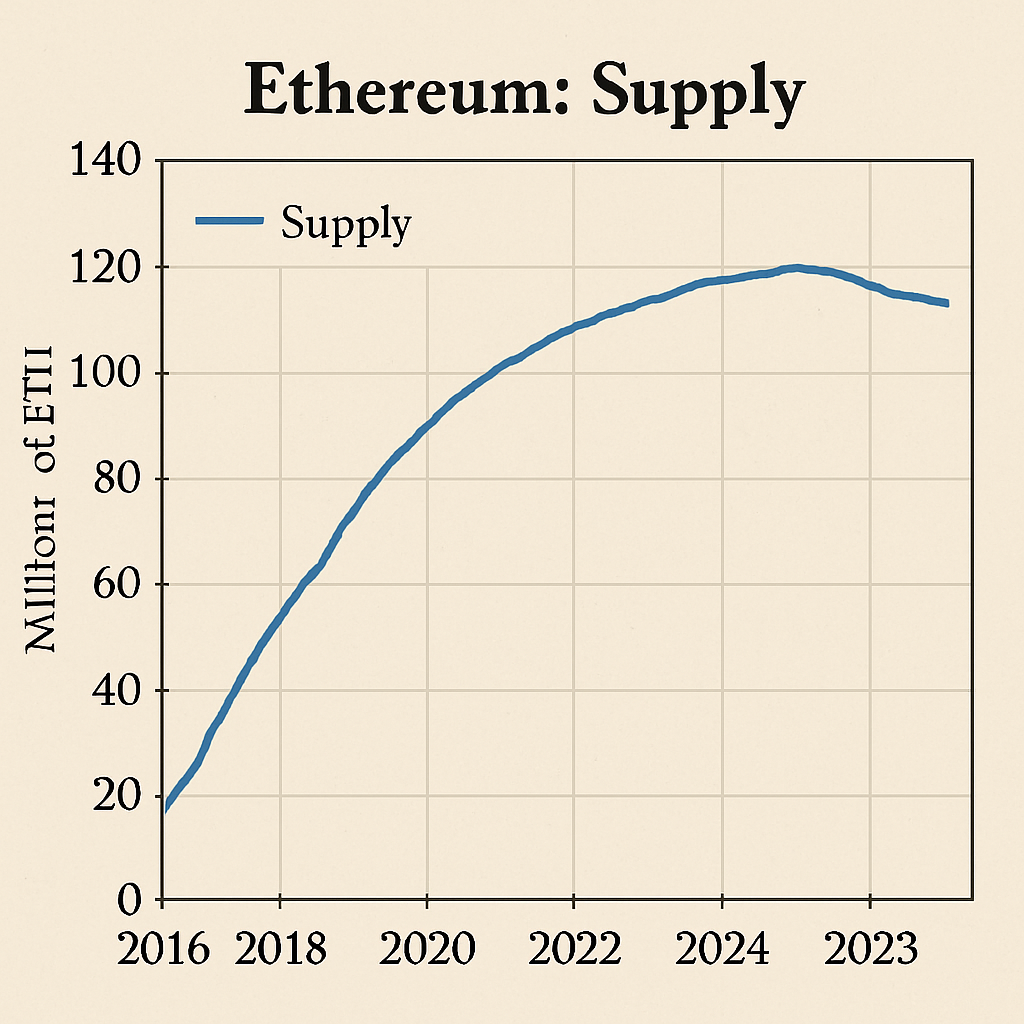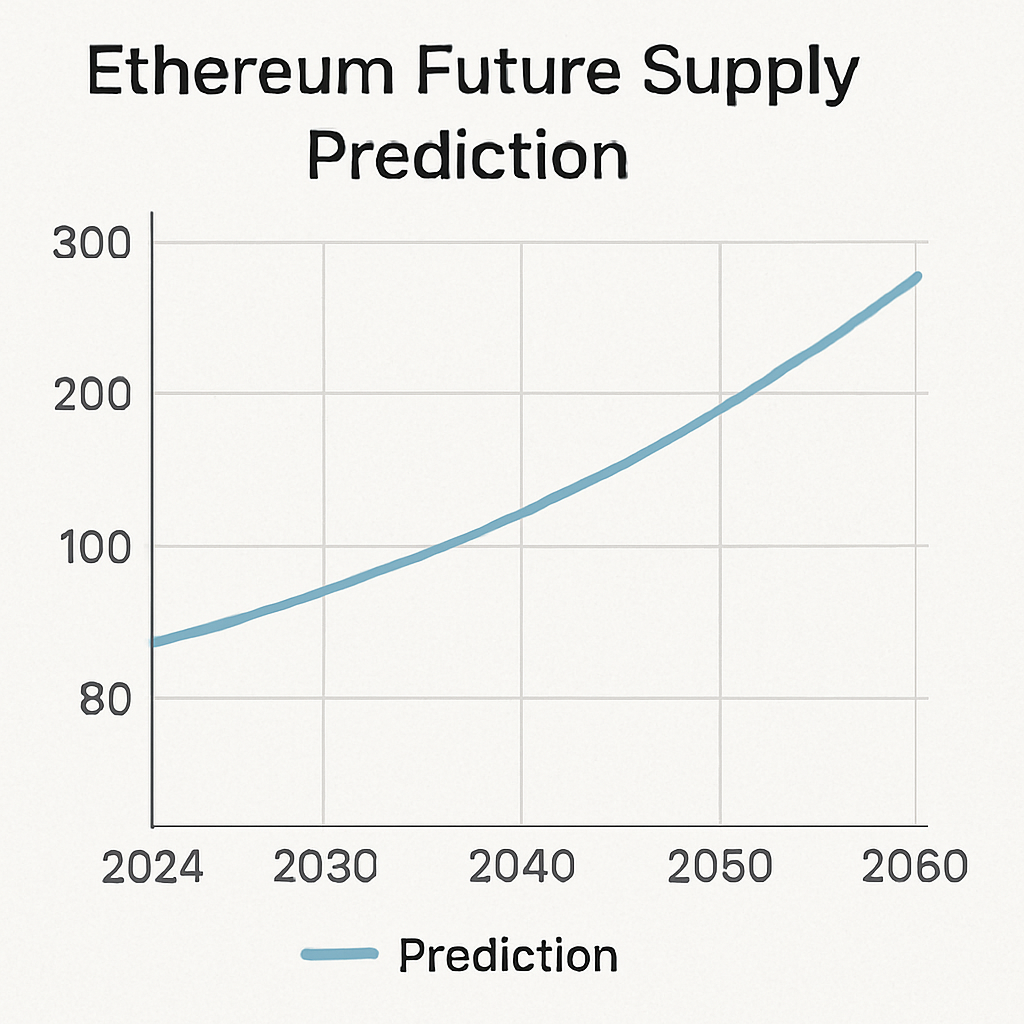Ethereum supply refers to the total number of Ether (ETH), the native cryptocurrency of the Ethereum platform, that is in circulation at any given time. Unlike Bitcoin, which has a capped supply of 21 million coins, Ethereum does not have a strict supply cap. This has significant implications for its inflation rate and its economic model.
Ethereum’s unlimited supply model contrasts sharply with Bitcoin’s fixed cap, providing flexibility in its economic structure. This lack of a cap allows Ethereum to adapt to varying economic conditions, but it also introduces unique challenges such as potential inflationary pressures that need to be managed through protocol upgrades and community consensus.
Ethereum Historical Data

Examining the historical data of Ethereum’s supply can provide insights into its growth trajectory since inception. The initial coin offering (ICO) in 2014 marked a significant release of ETH into the market, with subsequent years showing a steady increase in supply due to mining and staking activities. Analyzing this data helps identify patterns and potential future trends.
The ongoing creation of new ETH impacts Ethereum’s economic model, influencing everything from transaction fees to network security. Understanding the balance between supply and demand is crucial, as this dynamic affects Ethereum’s price stability and its appeal as a digital asset for both investors and users.
Understanding Ethereum’s supply is essential for several reasons:
The supply of ETH directly impacts its market price due to the basic economic principles of supply and demand. A high supply with stagnant demand may lead to price depreciation, whereas a limited supply with increasing demand can drive prices up. Investors keenly watch these dynamics to inform their trading strategies and investment decisions.
Ethereum’s inflation rate is a key metric for understanding its long-term viability and attractiveness as an investment. Unlike Bitcoin, Ethereum’s inflation is not predetermined, making it crucial to monitor how new issuance rates are managed through mechanisms like Proof of Stake (PoS) and proposals like EIP-1559.
The supply of Ethereum is intrinsically linked to its network security. Validators, who play a crucial role in maintaining the network, are rewarded in ETH. This incentive structure not only ensures the network’s robustness but also contributes to its circulating supply, making the understanding of supply mechanisms vital for assessing network health.
Proof of Stake (PoS)

Ethereum’s supply mechanism is governed by its protocol, which controls how new ETH is created and distributed. Initially, Ethereum used a Proof of Work (PoW) consensus mechanism, similar to Bitcoin, where miners were rewarded with new ETH for validating transactions. However, Ethereum is transitioning to Proof of Stake (PoS), which changes how supply is managed.
In the PoS system, validators are chosen to create new blocks based on the amount of ETH they hold and are willing to “stake” as collateral. This shift is significant because it not only impacts the supply issuance but also reduces energy consumption.
PoS is expected to significantly reduce the issuance of new ETH compared to PoW, leading to lower inflation rates. This reduction is a critical factor in stabilizing Ethereum’s economic model, as it aligns with the community’s goal of creating a more sustainable cryptocurrency ecosystem.
Validators in the PoS system earn rewards in ETH, contributing to the circulating supply. However, this contribution occurs at a reduced rate compared to mining rewards in PoW. The shift to staking not only affects supply but also encourages long-term holding, as validators must lock up their ETH to participate in securing the network.
One of the most touted advantages of PoS over PoW is its significant reduction in energy consumption. This transition not only aligns with global sustainability efforts but also enhances Ethereum’s image as an eco-friendly cryptocurrency, which could attract environmentally conscious investors and users.
Understanding trends in Ethereum supply is crucial for predicting future market behavior. By analyzing Ethereum supply charts, we can gain insights into its historical and projected supply dynamics.
Since its inception, Ethereum’s supply has grown steadily. The initial coin offering (ICO) in 2014 released a substantial amount of ETH into circulation. Subsequent annual issuance through mining and now staking has continued to increase the supply, albeit at a diminishing rate over time.
The ICO phase was a pivotal moment in Ethereum’s history, laying the foundation for its initial supply distribution. Understanding this period helps in grasping how Ethereum’s supply structure began and the early adopter incentives that shaped its initial market behavior.
During the PoW era, Ethereum’s supply expanded rapidly as miners were incentivized with substantial rewards. This period saw significant network growth but also faced challenges related to energy consumption and inflation, prompting the move towards PoS.
The shift toward PoS marks a new chapter in Ethereum’s supply dynamics. This transition is characterized by a more controlled and predictable issuance rate, which aims to balance supply growth with network needs and economic stability.
As Ethereum continues its transition to PoS, analysts expect the growth rate of ETH supply to slow down. This is primarily due to the reduced block rewards under PoS and the implementation of Ethereum Improvement Proposal 1559 (EIP-1559), which introduced a fee-burning mechanism.
EIP-1559 changes the transaction fee model by burning a portion of the fees paid in ETH, effectively reducing the overall supply. This deflationary pressure aims to counterbalance the issuance of new ETH, potentially leading to price appreciation if demand remains steady or increases.
Ethereum Future Supply Prediction

Predicting Ethereum’s future supply involves analyzing potential technological and protocol developments. Analysts consider factors such as continued PoS adoption, potential network upgrades, and broader market conditions to forecast supply trends and their implications on Ethereum’s market position.
Investor sentiment significantly influences the perception of supply adjustments. A well-managed supply can enhance trust and confidence among investors, leading to increased adoption and market capitalization. Understanding these dynamics helps investors navigate Ethereum’s evolving landscape.
For investors, understanding Ethereum’s supply dynamics is crucial for making informed decisions.
The interplay between supply and demand is a fundamental principle of economics that directly affects the price of Ethereum. A slower supply growth rate can lead to upward price pressure if demand remains constant or increases.
The balance between supply and demand directly impacts Ethereum’s price fluctuations. Investors must monitor how these dynamics evolve, particularly in the context of technological changes and market sentiment, to capitalize on price movements.
Understanding supply trends allows investors to develop strategies that consider speculative opportunities. By analyzing supply projections, investors can make educated guesses about potential price trajectories and adjust their portfolios accordingly.
Awareness of supply dynamics aids investors in managing risks associated with price volatility. By understanding potential supply changes and their market impacts, investors can better prepare for market shifts and mitigate potential losses.
The design of Ethereum’s transition to PoS and the implementation of EIP-1559 aims to enhance the network’s sustainability and security. These changes aim to decrease inflation, boost transaction efficiency, and fortify network security, all of which could potentially positively impact investor sentiment.
Ethereum’s transition to PoS reflects a commitment to sustainability, aligning with global trends toward greener technologies. This focus attracts environmentally conscious investors and enhances Ethereum’s long-term viability as a digital asset.
PoS’s security improvements play a crucial role in preserving investor confidence. A secure network ensures transaction integrity and reduces the risk of attacks, making Ethereum a more attractive investment option.
Continuous protocol upgrades and improvements are vital for Ethereum’s longevity. Investors should stay informed about potential upgrades, as these changes can significantly impact Ethereum’s market dynamics and investor confidence.
Ethereum’s supply dynamics are a pivotal aspect of its ecosystem, influencing its price and adoption. As Ethereum transitions to a more sustainable model with PoS and integrates features like EIP-1559, understanding these trends becomes even more critical.
The network’s broader economic and security model deeply intertwines with Ethereum’s supply, making it more than just a matter of numbers. These dynamics influence everything from market behavior to technological advancements, necessitating a comprehensive understanding for all stakeholders.
Both seasoned investors and newcomers can gain valuable insights into the potential future of this versatile cryptocurrency by closely monitoring Ethereum supply charts and analyzing these trends. Staying informed about supply dynamics allows participants to navigate Ethereum’s evolving landscape with confidence.
As Ethereum continues to evolve, the importance of understanding its supply trends cannot be overstated. Whether you’re an investor, developer, or user, a thorough grasp of supply dynamics is essential for making informed decisions in the ever-changing world of cryptocurrency.

In summary, Ethereum’s supply dynamics are not only about numbers but are deeply intertwined with the network’s broader economic and security model. As Ethereum evolves, so too does the importance of understanding its supply trends for anyone involved in the cryptocurrency space.

No responses yet